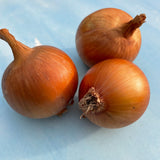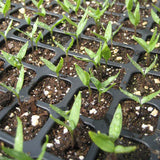
How to Harvest and Store Vegetables for Winter - Part 1
Erin Enouen is one half of the farming duo that runs Long Season Farm, a small, diversified, certified organic vegetable farm here in the Hudson Valley focusing on four season production. Before moving to Long Season Farm full-time, Erin worked with us for 5+ years (while also co-running Long Season Farm on the side!). While here, Erin shared her top tips for harvesting and storing crops for winter based on her own experience. Her tips are so useful, we decided to share them in a 3-part series. Today, Erin focuses on vegetables you should harvest before frost. Next week, we'll look at vegetables that benefit from some frost but that should be harvested before a hard freeze. In the final week, we'll share vegetables to harvest before the ground freezes solid. And with that, we'll leave you with Erin:
"My experience running a winter-focused vegetable operation has taught me that the two most important considerations when storing crops for several months are harvest and handling techniques. When you harvest a crop is just as important as providing it with the proper conditions to keep all winter. The when depends on frost. Some crops will get damaged by a frost, others benefit from it. If your garden is still producing great roots and other storage crops, you might be wondering about the optimum time to harvest them. Here is the Long Season guide to maximizing harvest timing and storage technique to have the best quality crops all winter."
CROPS TO HARVEST BEFORE FROST
Frost will damage some storage crops, making them rot instantly or significantly reducing their storage abilities. Frost can occur between 33 and 39 degrees, depending on humidity.
1. Winter Squash
Harvest: Winter squash and pumpkins are ripe when their flesh is full color and the stem is hard and dry. For best storage, always harvest before temperatures dip below 43, even if they aren't all quite fully ripe. Handling: For most winter squash, a curing process is necessary to extend their storage abilities and convert starches to sugars, sweetening them up. Post-harvest, remove any dirt or debris and lay squash in a single layer in a warm, sunny spot. We use our greenhouse with all fans on to keep moisture from collecting on the skins. Cure for at least 2 weeks. The exception to this are Delicata and Acorn types. The curing process will diminish their flavor and storage capacity.
Storage: Store in a dry, dark, cool place. Do not allow them to freeze. Pantries and attic spaces are ideal places in the home.
Best Varieties: Waltham Butternut, Black Forest Kabocha, Burgess Buttercup
2. Dry Beans
Harvest: In the Northeast, I recommend harvesting dry beans before frost, especially if the entire crop is not fully dry. Ideally, harvest your beans when the pods are dry. For faster processing, harvest the entire plant and place in a warm dry sunny spot to fully dry. Handling: The handling process for dry beans is basically seed saving. Once the plants and pods are fully dry and crisp, thresh them. Place dry and crisp plants clean tarps and whack each plant till all the pods shatter. Collect the beans and make sure they are fully dry before storing. Storage: Store in an airtight container once dry.
Best Varieties: Black Turtle, Jacob's Cattle, (pictured above), Light Red Kidney, Silver Cloud Cannellini

3. Potatoes
Harvest and Handling: Potatoes also require a curing process, though this happens before harvest. Once your plants have died back, be sure to leave them in the ground for at least 2 weeks. This period allows the skin to toughen. To harvest, gently dig potatoes with a garden fork, taking care not to spear any. Do not wash. Storage: Potatoes like air flow, but not totally dry storage. This can be a tricky environment to create. One year we placed our potatoes in tubs with lids, but too much humidity collected in the winter. We now use crates that we cover with plastic in our cold storage room. However, a dry basement or attic space is also a great spot with a similar set-up.
Best Varieties: we don't sell potato seed currently but let us know your favorite varieties in the comments!
Stay tuned - next week, we'll explore crops to harvest soon after the ones featured above, before a hard freeze.








